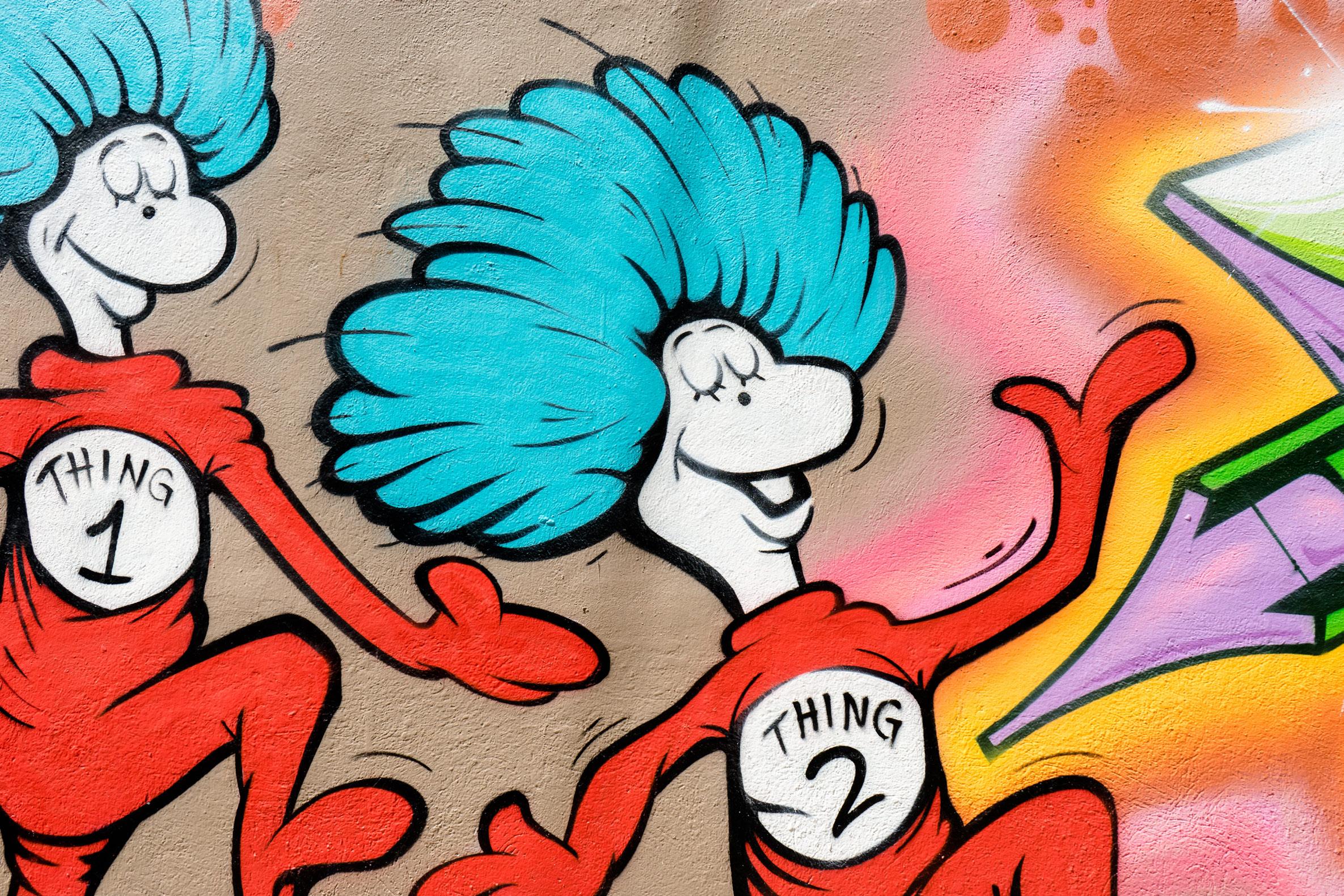
9 minute read
THUS SPAKE HORTON
HORTON HEARS A ...
by Christina Pettinato
Advertisement
On the fifteenth of May, in the jungle of Nool, In the heat of the day, in the cool of the pool, He was splashing…enjoying the jungle’s great joys… When Horton the elephant heard a small noise.”
With tales set in fantastic places and featuring a cast of extraordinary characters of seemingly all shapes, sizes and colors, Theodor Seuss Geisel, known to the world as Dr. Seuss, has delighted readers of all ages.
Horton Hears A Who, fuses the tenets of existential theory with a simple story of an elephant named Horton. Horton hears voices. Not in a clinical sense, but in a very real and phenomenological way. A random, diminutive “speck” of dust, cast to the wind, drifts into Horton’s world of the Jungle of Nool. From this seemingly insignificant particle of dust Horton encounters a unique community known to its citizenry as “Whoville.” From his discovery, Horton struggles to keep the existence of Whoville protected, and in order to do this, he must prove to the other residents of Nool that “A person's a person, no matter how small,” or in this case, a Who is a Who no matter how small. Think Plato’s allegory, only told in vibrant verse by an anthropomorphic pachyderm.
Horton’s commitment to the Whos and their potential annihilation does not deny the axiom of death, but instead represents life affirmation (Roffey, 1993). In this sense, Horton’s confrontation with death ignites an awakening experience which alters his life’s purpose. This message is also conveyed by the thoughts of psychotherapist Emmy Van Deurzen (2002), as she explains that living life to the fullest can only come from facing the inevitability of one’s own demise and death. In a moment of great choice Horton determines that his meaning or life’s project is to protect the small and vulnerable Whos, both from of sense of commitment to others and as an acknowledgment of his own mortality. This confrontation with death illustrates Horton’s awakening experience, which ultimately transforms and enriches his life. Indeed, Horton’s attitude shifts as the story unfolds. Initially we find him leisurely enjoying his day in the pool of Nool. He is quite unacquainted with his life, while by the end of the story he embodies an appreciation of meaning and purpose.
“We must become invisible, travel silently, for there are forces that would seek to destroy us.”
With these heroic acts, Horton takes on the role of a supreme being. In the eyes of the Whos, Horton is a god. He is physically capable of saving the Whos, while remaining unknown, seemingly infallible, “Don't bother looking,” quips the Mayor of Whoville when questioned about Horton’s existence, “He's invisible.” Horton as deity introduces the existential theme of death transcendence into a children’s story. As death awareness is heightened, individuals may attempt to bolster the legitimacy of their religious faith (Vess, Arndt, Cox, Rout-
ledge & Goldenberg, 2009). Death transcendence is a defense mechanism that distracts us from the absolutes of our existence. Namely, the only truths that are certain for all homo sapiens is the occurrence of physical and emotional pain and death. Nothing else is given or guaranteed. Belief in Horton means salvation for the Whos. Indeed, this softens the pain of ultimate annihilation through some vision of everlasting life (Yalom, 2008). The presence of Horton gives strength to the Whos and creates a belief that there is something out there greater than themselves. Belief in an ultimate rescuer suggests a divine intervention and to embrace this will save us from the horror of nonexistence (Murdock, 2009). Furthermore, the idea of everlasting life abates the fear of isolation by providing an infinite existence. To avoid recognition of death and isolation is to exist inauthentically.
Friedrich Nietzsche created for us in his own image Zarathustra, a being enlightened to the truths of the Übermensch. Nietzsche’s Zarathustra postulates the Übermensch as an actualization for humanity, a rising above the adage that to err is to be human. Like Zarathustra, Horton is a work of allegory, a becoming of the Superman and to part from the common man, albeit in a less bombastic way than Nietzsche’s character. Although their pathways to the masses are different, both characters undergo a transformation, an awakening and an acceptance to teach those who are unaware of the expansiveness of existence.
Horton no longer believes solely in the life he once knew. As he fights and advocates for the Whos, he struggles with this new way of existing. He becomes a superior being; one who separates himself from the mass of society and stands alone in reliance of the self in the presence of life’s absolute truths. We see Zarathustra exhibit the same passion, “I go not your way, ye despisers of the body! Ye are no bridges for me to the Superman!” Zarathustra passionately disengages from those who denounce the self for what it encompasses. He recognizes the truth about the self, which calls us to strive in a world of struggle.
Zarathustra and Horton become agents for change in the development of the self. Zarathustra’s Superman presents a new found wisdom geared to help mankind become more than the prisoners of the dead. “I want to teach men the sense of their existence which is the Superman, the lightning out of the dark cloud-man.” Like Horton, Zarathustra professes of a world separate from his own. He urges society to embrace the Superman and adhere to the struggles life will bring for the sake of freedom. Similarly, Horton attempts to transform his neighbors by introducing his knowl-
edge of the Whos. “Believe me, I know there is a person down there.” Zarathustra and Horton both face dangerous criticism from those who will not heed their words.
With great knowledge comes great risk. To become the savior of Whoville, Horton encounters condemnation and becomes the Loon in the Jungle of Nool. As Horton preaches the existence of the Whos, the neighbors of his world do not believe in the existence of a single Who. “I think you’re a fool! You’re the biggest blame fool in the Jungle of Nool!” is the response Horton endures after asking his fellow Noolians to believe in the existence of Whoville. Zarathustra endures similar resistance, “Leave this town, O Zarathustra, there are too many here who hate thee.”
Townsfolk afraid of change and the possibility of a new existence beyond their knowledge is a powerful, and common, narrative within literature that Seuss and Nietzsche expound on with their own style and finesse. Those encapsulated in ontic domestication will deny new truths, resist change, and ultimately be crushed under the weight of their ignorance. Indeed, a sign of the times that dangerously transcends culture and time.
When those who do not believe in a new idea, theory or proclamation they attempt to defend the status quo by eliminating or silencing that which they do not understand. For instance, Horton has his limbs and throat tied by a gang of monkeys who want to silence his message. “You’re going to be roped! And you’re going to be caged!”
It is the common man who resorts to violent acts in response to something he does not understand — nothing new here.
Yet, both Horton and Zarathustra are steadfast in their resolve. “Behold the good and just! Whom do they hate most? Him who breaketh up their tables of values, the breaker, the lawbreaker:-he, however, is the creator,” Zarathustra declares. Indeed, both Horton and Zarathustra accept a life worth living by having the courage to question and take action.
“My happiness should justify existence itself”
In his quest, Horton moves through deeper and deeper stages of self-realization and, hence, despair (Beck, 2004). It is our major task to invent a meaning sturdy enough to support a life and the distress it impedes upon us (Yalom, 2002). For Horton, saving the Whos from death becomes his purpose.
The effort that Horton displays in this story demonstrates a strong resolve for meaning.
Horton recognizes that he alone must prove the existence of the Whos. He understood that, to create meaning, the realization of our isolations is unavoidable (Murdock, 2009). Thus, he fought to prove their existence, which in turn allowed Horton to fully develop a more meaningful relationship with the Whos. This is clearly illustrated at the end of the story when Horton vows to protect Whoville for as long as he can. Horton’s ability to accept this responsibility allows him to develop meaning behind his being-in-the-world.

The tale of Horton illustrates basic tenets and themes of existentialism by adhering to many of the givens of existence: death, meaning, responsibility and isolation. Thus, signifying that the success of Dr. Seuss’ stories have as much to do with incorporating existential themes as they do with presenting colorful characters, fantastical settings and rhyming prose.
REFERENCES
Beck, R. (2004). The Function of Religious Belief: Defensive Versus Existential Religion. Journal of Psychology and Christianity, 23, 208-218.
Dr. Seuss. (1954). Horton Hears a Who. New York: Random House
Murdock, N. L. (2009). Theories of Counseling and Psychotherapy. New Jersey: Pearson Education.
Nietzsche, F. Thus Spake Zarathustra.
Roffey, A. E. (1993). Existentialism in a post-modern world: Meaningful lessons. Counseling and Values, 37, 129-148. ABOUT THE AUTHOR
Christina Pettinato is a mental health professional with more than seven years of experience having served adults, adolescents and children with a wide range of mental health issues at one of Pennsylvania’s premier mental health clinics. She is a Licensed Professional Counselor, a National Certified Counselor, and a Distance Certified Counselor.
Yalom, I. D. (2002). The gift of therapy: An open letter to a new generation of therapists and their patients. New York: HarperCollins.
Yalom, I.D. (2008). Staring at the Sun. San Francisco, California: Jossey-Bass.
Van Deurzen, E. (2002). Existential Counselling & Psychotherapy in Practice. London: Sage Publications
Vess, M., Arndt, J., Cox, C.R., Routledge, C., Goldenberg, J.L.(2009) Exploring the Existential Function of Religion: The Effects of Religious Fundamentalism and Mortality Salience on Faith-Based Medical Refusals. Journal of Personality and Social Psychology, 97, 334-350.

PUBLISHER Don Laird
EDITORS Don Laird Pilar Brown
CONTRIBUTORS Don Laird, MS, NCC, LPC, DCC Morgan Roberts, MSPC Christina Pettinato, MS, NCC, LPC, DCC
PHOTOGRAPHY Photos courtesy Unsplash.com
DESIGNER Pilar Brown
CONTACT www.eTalkTherapy.com/contact
Do you have an idea for a article, would you like to contribute to our magazine, or do you have an interest in learning more about The Accidental Existentialist? We are always on the look out for topics to discuss, explore and amuse.
The Accidental Existentialist is a trademark of eTalkTherapy, LLC. Unless otherwise indicated, all content and designs © Copyright 2018 eTalkTherapy™ and eTalkTherapy.com. All rights reserved.
This magazine does NOT provide medical advice. The content is for entertainment purposes only. Consult with your doctor on all medical issues regarding your condition and treatments. The Content is NOT intended to be a substitute for professional, psychiatric or medical advice, diagnosis, or treatment, nor does it replace the need for services provided by a medical or psychiatric professional. Always seek the advice of a medical professional, psychiatrist or therapist before making any changes to your treatment.
CONNECT WITH US ON SOCIAL MEDIA

Check us out on Facebook, Twitter, Instagram, Linkedin and other social networks. Or contact us directly online at eTalkTherapy.com.



